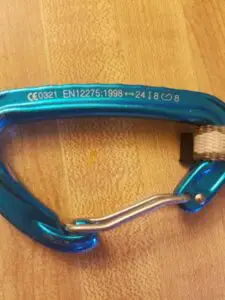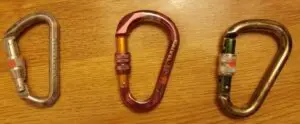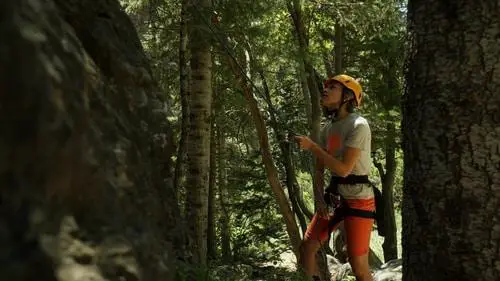While there are lots of different belay devices on the market for climbers, the GRIGRI has established itself as one of the safest and most popular options. A GRIGRI is only as safe as the carabiner it’s secured to your harness with though, so it’s really important to select one that’s compatible.
What is the Best Carabiner to use with a GRIGRI? This chart shows a few of the best options and the reasons behind the choices.
Carabiner Safety
The main reason to use a special carabiner for your belay device is to avoid cross-loading. This happens when the carabiner rotates around between the belay loop on your harness and the belay device so that the force is on the minor axis instead of the major axis. Essentially, the force of the climber’s weight is exerted against the gate of the carabiner, which is the weakest part.
This can be extremely dangerous, as the force from a long fall could snap the carabiner and send the climber hurdling to the ground. As explained in detail later on, carabiners for climber are strength-tested along the minor axis, and the strength of 7-9kN should be adequate to withstand any force generated by a falling climber.
That being said, accidents still do happen rarely. It’s best to have some sort of contingency to avoid cross-loading and keep the force along the major axis with a strength of more than 20kN.
Carabiners for GRIGRI
This is not an extensive list of every carabiner that works well for a GRIGRI, but does show each of the various styles that people use to limit the chance of cross-loading a carabiner.
Black Diamond Gridlock
The Gridlock family of carabiners are specifically designed for belay devices. They have a pretty unique hourglass shape with a separate area for the belay device to go so that it doesn’t rotate around and interfere with the gate. The closure for the internal gate varies by brand, but most of them are easily manipulable by hand.
Note that the GRIGRI should always go on the small side of the carabiner, behind the internal gate. If you put your harness belay loop behind the small internal gate, the GRIGRI can still crossload.
Gridlock carabiners have multiple options for closure systems, including screwlock and autolock. One of the most popular is the Magnetron, a magnetic closure unique to Black Diamond. The downside to the Gridlock carabiners is that they can’t really be used for other stuff.
View Price on Amazon: Black Diamond Gridlock Screwgate Carabiner
The Grivel Clepsydra is very similar, but with a twingate closure system. The DMM Ceros
is very similar, but with a twingate closure system. The DMM Ceros has the same shape as the Gridlock carabiners, with the addition of the “horn” on the DMM Rhino.
has the same shape as the Gridlock carabiners, with the addition of the “horn” on the DMM Rhino.
Petzl Spirit
The Petzl Spirit is a classic screwlock carabiner. The shape is very asymmetrical to try to keep the carabiner from crossloading, but there are no additional safety features. As long as there is tension on the harness and belay device it won’t spin, but it could spin around whenever there’s slack.
These are safe- a lot of climbers use them with GRIGRI’s and other belay devices. You just need to keep an eye on it and not let it get hung up on the gate and cross-load. The Spirit is actually one that Petzl specifically recommends for use with the GRIGRI.
The carabiner gate has a “locking indicator” that is red when the gate is open to try and catch your eye in case you forget. The red marking is covered by the locked sleeve.
Petzl makes a lot of similar carabiners with various locking systems. This one is one of the cheapest options, coming in at around $15.
View Price on Amazon: Petzl Spirit 3D Screwlock
Edelrid HMS Strike
This is one of the simplest carabiners designed specifically for belay devices. It has a standard HMS shape with an internal gate clip on the narrow side. You can pretty much pick any type of closure system, screwlock, twist lock, slide lock, or triple lock. The H shape saves on material, which saves on cost and weight.
The nice thing about the HMS Strike is that you can use it in other applications as well, such as for anchors and tethers. It isn’t only good for belay devices.
View Price on Amazon: Edelrid HMS Strike Locking Carabiner
The Metolius Gatekeeper is almost identical, but with a slightly different shape.
is almost identical, but with a slightly different shape.
Petzl Freino
The most unique option is the Petzl Freino. This carabiner has a ‘friction spur’ on the spine, which makes it easier to keep the GRIGRI from twisting around or cross-loading. As long as you’re not dumb enough to clip into the wrong side of the carabiner, this is a great choice for belaying with a GRIGRI.
The other big advantage is the use of the friction spur to slow the descent. The GRIGRI pretty much has one speed when it comes to lowering, though you can try to control it better by adjusting the brake lever. With the friction spur you can easily adjust the speed of the climber as you lower them.
The Freino is the most expensive carabiner on this list, and is a bit overkill to me. The functionality is nice, especially with the friction spur, but isn’t completely necessary in my opinion. You may consider it if you routinely belay people who weigh a lot more than you do, as it will help them stay under control.
View Price on Amazon: Petzl Freino with Friction Spur
DMM Rhino
The Rhino is the best named carabiner on the list, in my opinion. The innovation here is the ‘horn’ on the spine. The spine on the widest part of the carabiner sticks out a little bit so that the GRIGRI cannot slide over it. It maintains a standard carabiner shape, so you can use it for other things too.
The Rhino is the strongest carabiner on the list, though anything above 22kN is overkill. There are a few different locking types for the Rhino, so you can pick whichever you prefer.
View on Amazon: DMM Rhino Locking Carabiner
The DMM Ceros is also a good option, since it includes the internal clip like the Gridlock carabiners.
is also a good option, since it includes the internal clip like the Gridlock carabiners.
What to Look for in a Carabiner used with a GRIGRI
When climbing all day, you often end up removing your carabiner and belay device twenty or thirty times. It needs to open easily when intended, and never open on accident. There are a few different features for carabiners, and here’s a breakdown of them-
Strength and Testing
Everybody always wants to know how much weight climbing gear can hold! The easiest answer is that any gear that is tested and certified by the UIAA or CE is strong enough to handle anything you might experience when rock climbing.
In order to get the stamp of approval from the UIAA, carabiners have to be able to handle a force of at least 20kN, the equivalent of about 4500 lbs (2000 kg). The physics equation Force=Mass*Gravity provides the actual strength requirements for a carabiner catching a lead fall.
Don’t be confused though, just because a carabiner can hold the equivalent of 25 climbers doesn’t mean you should try it out. The force equation factors in the effect of gravity. A carabiner can hold the 4500 pounds or 20kN, but only in a static environment. With a fall of even a few inches, the gravity component increases the force factor.
Even with this additional factor, climbing gear can handle the force required. Studies from the UIAA and Petzl have found that the maximum force of a falling climber is around 5-6kN, so 20kN+ is plenty.

Carabiners are tested in 3 ways, across the major axis, across the major axis with the gate open, and across the minor axis. The ratings are stamped on the sides of all climbing-rated carabiners.
With the gate open and across the minor axis carabiners have a lot less strength- usually as little as 1/3 as much. This is why it’s so important not to let carabiners cross-load.
Locking Mechanism
We’ve come a long way since the original screwgate carabiners, though screwgates are still some of my favorites. The first autolocking carabiners debuted in the 70’s, but weren’t widely adopted because of the increased weight and difficulty of opening. Climbing has become more safety-conscious since then, and autolocking techniques have improved as a result.
Screwgate: Internally threaded sleeve screws over the hooked closure system, securing it in place. Completely manual, but can close without locking. If you forget to screw it closed, it remains unlocked and unsafe.
Dual Action: Also known as “autolock,” the sleeve is spring loaded so it spins closed automatically when the sleeve hits the nose. Each brand has their own specific term for a twist lock carabiner, but the functionality is the same. Faster to use than a screwgate, but it can get caught on the rope or something and not close.
Triple Action: Similar to the Dual Action closure, but the first step is to slide the sleeve down before spinning it and opening it. Depending on your hand size, it can take two hands to open.
Magnetic: Black Diamond has a popular carabiner with a magnetic closure system. To open and close it, you pinch the sides of the gate. It is very fast and easy to use, but can get gummed up when climbing outdoors in bad weather.
Twin Gate: Opening the gate requires two steps. First you release the ‘safety’ gate, and then you open the big gate. These are fast to work with, but take a little while to get used to. Again, each company uses a slightly different terminology for this closure system.
Material
Climbing carabiners are either made out of aluminum or steel. Steel carabiners have many benefits, including strength and durability, but they are also a lot heavier and more expensive. Because of this, most people use aluminum carabiners.
All of the options we recommend for use with the GRIGRI are aluminum because the rope does not rub and wear down the carabiner. If climbing or rappelling with a tubular belay device like an ATC or other device that uses a carabiner for friction, you could consider using a stainless steel carabiner.
Shape

Carabiners come in many different shapes and sizes. Originally they were all oval-shaped, but over time manufacturers found that using different shapes can help to keep the forces away from the weaker gate area.
The D-shape helps keep the carabiner from rotating and shifts the load to the carabiner’s spine instead of the gate. Old carabiners were almost always oval-shaped, which often lead to dangerous cross-loading.
Avoid pear-shaped carabiners for GRIGRI belaying. They can easily rotate and become compromised. They still should be strong enough, but it’s best to be cautious.
Other features
There are a few other features with climbing carabiners that are worth taking a look at. Most of the carabiners on this list have an internal gate that helps keep it from cross-loading.
In general, it’s good to try and buy gear that’s a similar color so that you don’t mix it up with your partner’s gear. Mark them with a unique color of nail polish or tape to identify them.
Different carabiners have different diameters. The widest diameter carabiners are stronger, but also weigh more. They also have different opening sizes that are for different things. Carabiners for belay devices are usually smaller because they don’t need to secure thick ropes or multiple carabiners.
Conclusion
In order to avoid cross loading, you should consider using a specialized carabiner that will help keep the force of the climber oriented across the major axis.
A lot of people do just use standard carabiners and get in the habit of checking it so that it doesn’t get cross-loaded. I think it’s best to use a specific carabiner for belay devices so that you don’t even need to worry about it.
The options recommended above are all better than a regular carabiner, but each has its own advantages and disadvantages. I think the Rhino and Strike are the most versatile, as they can be used in other applications as well.
The best one for you will depend on how much gear you have and whether you usually climb with new climbers or more experience climbers.
See Also:
How Much Weight Can a Quick d
d raw Hold?
raw Hold?














